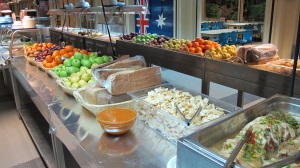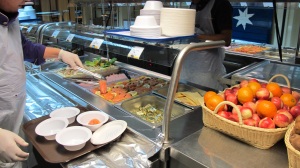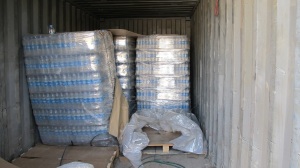Deploying to the MEAO - Day 14
Day 14 - "an army marches on its stomach"
Napoleon Boneparte was spot on when he (is credited to have) said: "an army marches on its stomach", I haven't noticed a lot of marching going on around the base, but there's certainly a lot of eating!
The food at the Aussie mess in Tarin Kot is excellent. There is fresh fruit and salads at every meal - I tasted okra for the first time and pounced on the mangosteens (an exotic fruit even in Asia where they grow). A full hot breakfast is available from 5.30 - 9.15am. The food is cooked in stages, so that the tomatoes, hash browns, mushrooms, baked beans, bacon and eggs (scrambled, boiled, poached or fried) are as fresh as possible. If you don't want something heavy, you can savor the fresh grapefruit and danishes baked on-site.
Today I interviewed the soldier-chef, WO2 David Mooney, who manages the catering contract for Multi-national Base Tarin Kot. He was passionate about his job and fully understood the link between food, nutrition and morale. He is currently feeding about 1600 people at four meal times each day - they offer supper at 11pm -1.30am (bascially a second dinner) for the people coming off night shifts. Last September, when 7RAR (Royal Australian Regiment) took over from 3RAR and all the men came in from the Forward Operating Bases and Patrol Bases which are "outside the wire" (of the base) the number of hungry mouths more than doubled.
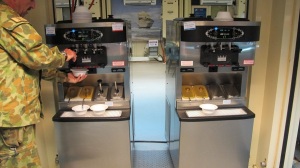
- Soft serve icecream machines - vanilla, strawberry and chocolate - a popular choice for the Yankee diners
I was interested in how you feed an army after doing some research on food at Gallipoli. In 1915, the men existed on tins of bully beef, tooth-cracking biscuits and sweet, black tea. There would be a riot if you served this to the modern Aussie soldier!
As you can imagine, if any of the food gets contaminated or hygiene standards slip, then food posioning or gastroenteritis can wreck havoc on an army. This happened to British troops about a week after they invaded Iraq in 2003 when 1,340 troops got gastro and 73% of them required hospitalisation. http://www.ncbi.nlm.nih.gov/pmc/articles/PMC3366745/ It also happened at Gallipoli where the majority of the men got sick during the summer months as flies flew from the shallow pit latrines into the mouths of hungry diggers.
To help prevent the spread of desease, everyone at Tarin Kot has to wash their hands and use alcohol disinfectent before entering the mess. Food preparation areas are separated for meat, fresh fruit and vegetables, and breads, cakes and pastries. The temperature of food is tested every hour that it is available at the serving points. A sample of everything served in the mess is kept and labelled so that if anyone does complain of food posioning, the food can be tested for bacteria.
The statistics and logistics are staggering. The catering company employs 109 staff who work 12 hour shifts and eat together when they have finished serving the rest of the base. They have a budget of $26/person/day - the price is higher than it would be in Australia due to the transport costs. There is a stockpile of about a month's worth of food for 1600 people kept on site, just in case the base gets attacked and supply trucks and planes can't come in and out.
Every couple of weeks, Afghan 'jingle' trucks each deliver 8 crates of water bottles to the base. Each crate contains 2016, 500ml water bottles. That's 161,128 water bottles with an average of 7 bottles (3.5 litres) per person per day. The ANZACs at Gallipoli were given a water ration of about 1.25 litres per person per day, but usually had to survive on less because fresh water was so hard to come by. Perhaps this ANZAC day, we should lay a water bottle instead of a wreath of flowers, in memory of the soldiers who suffered diarrhoea, dehydration and malnutrition.
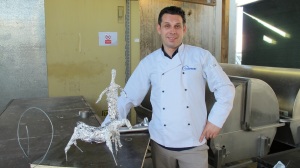
- 'Monty', one of the chefs at TK prepares the base for his pastry sculpture of Simpson and his donkey for ANZAC Day
Twelve months ago I went to the Middle East Area of Operations (MEAO) with the Australian War Memorial. I was working on an oral history-photographic project. The core part of the project was interviewing and photographing 19 currently serving members of the ADF - from the army, navy and airforce - before, during and after their deployment in 2013 to the MEAO. In another 12 months time, you should be able to see the results of this work in an exhibition which will travel around Australia.
These blog posts were written while I was in the MEAO but were not uploaded to the AWM website at that time.
I am planning to upload one blog post each day, exactly 12 months on from the actual day I was on deployment. We left Canberra on 12 March 2013.
